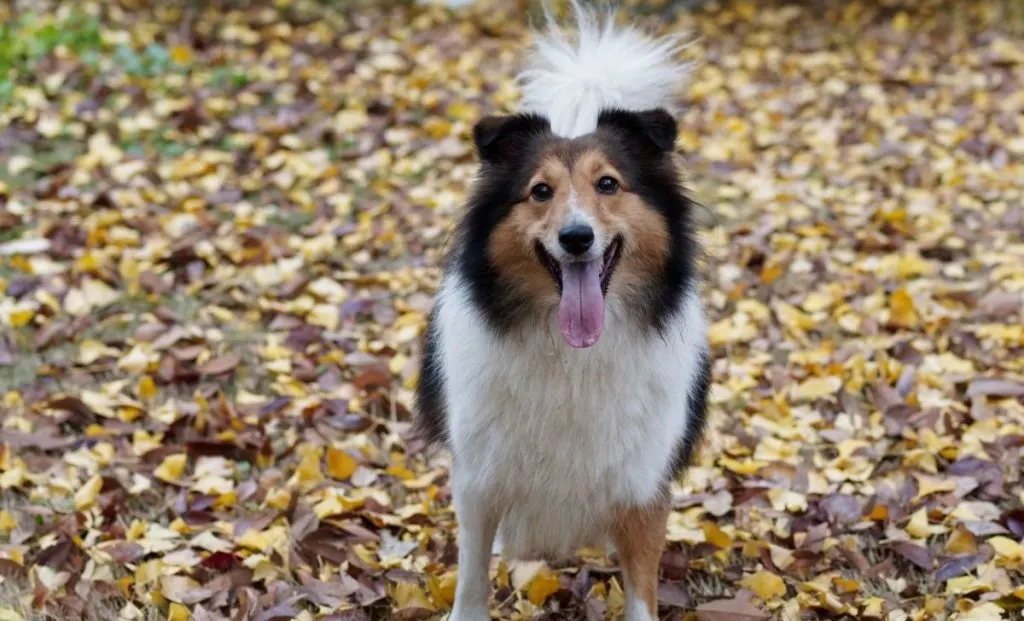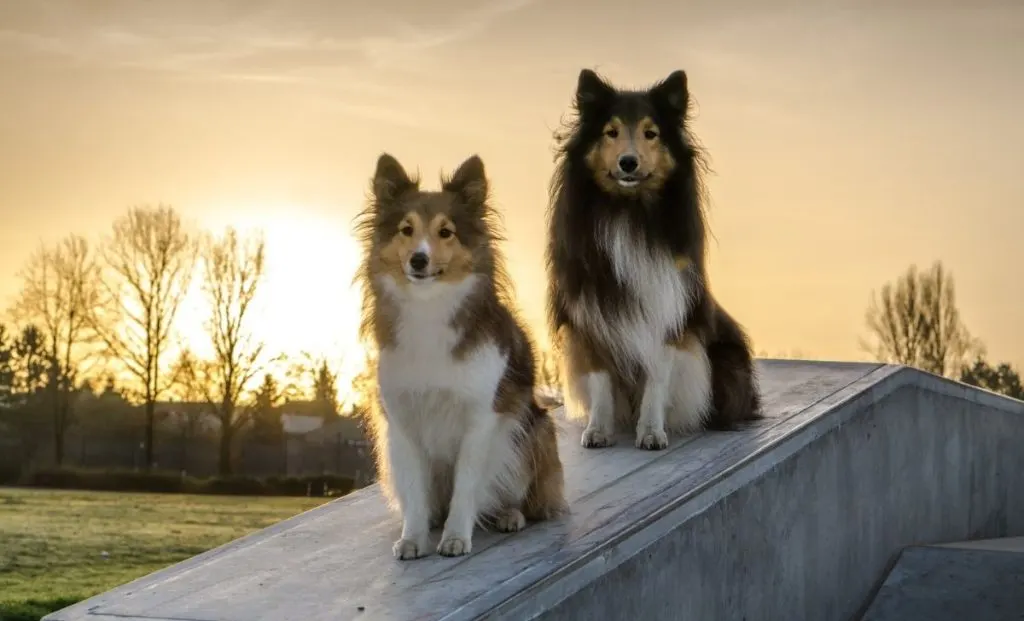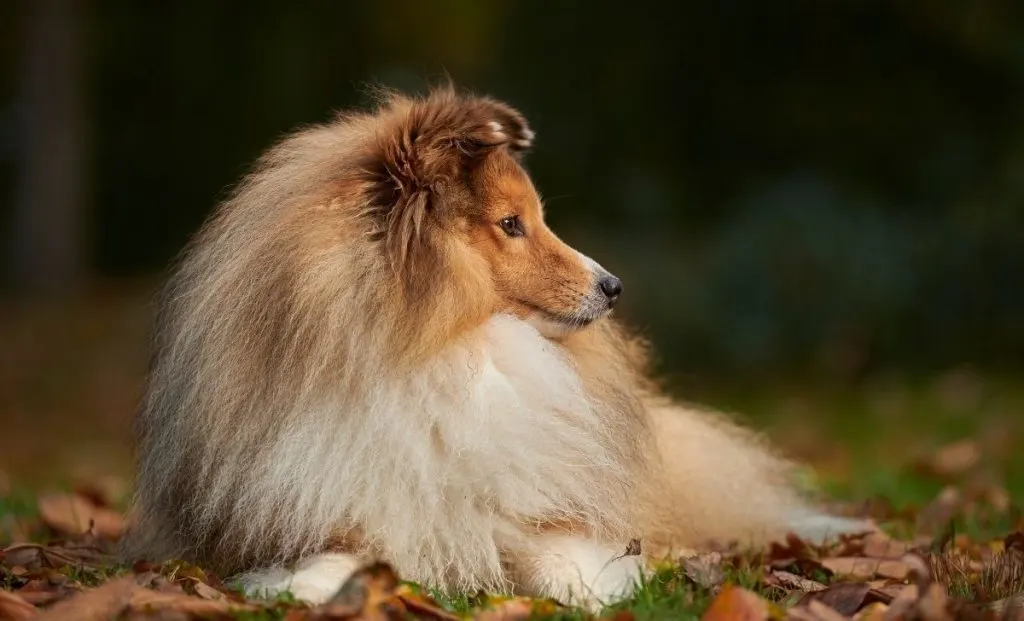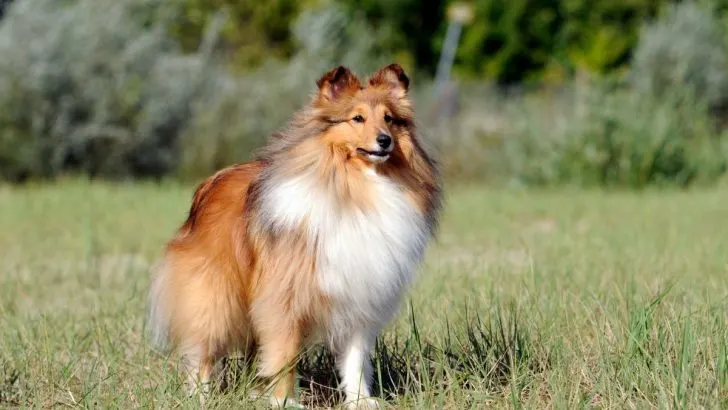Whether you want a new puppy for the show ring or work, finding a miniature Sheltie pup and bringing it into your life is like introducing a small ray of sunshine into every precious moment of your day.
These adorable, sweet fur babies, often called Shelties because they come from the Shetland Islands, are the ideal little companions, equally rated in intelligence and energy.
These amazing dogs are usually in good health and have unique looks and coat colors.
We’ve made a comprehensive Shetland Sheepdog growth chart that also guides owners for a healthy weight by the breed standard, height ranges, ideal diet, and their different growth patterns.
You will be able to see the size of Shelties divided by sex in helpful charts. There is a good chance all of this information will be crucial for you while raising your new puppy.
Whether you’re a lifelong Sheltie parent or new to this great breed, tracking your pup’s development will be fun and informative.
So, grab some tea and watch the exciting stages of your Sheltie’s growth.
Male VS Female Shetland Sheepdog Growth

In their way, Shetland Sheepdogs—both males and females—have unique charm and features.
Although they may have the same loyal, intelligent, energetic, and charming temperament, their growth patterns can be varied. They are worthy of note for any potential Sheltie owner.
Male Shetland Sheepdog Growth
This will enable you to track the development of a male Shetland Sheepdog as he is on his way to growing into healthy and happy adult status.
With a height and weight chart, you can follow the steps from a little puppy to a full-grown dog.
This will allow you to monitor these milestones to ensure he grows correctly, catching any potential problems before they compound into real issues.
Let’s jump into the typical height ranges for male Shelties on their way to full growth.
All the information for the following helpful chart was sourced from the breed standard the American Kennel Club (AKC) follows.
Male Sheltie Height Chart
| Age | Height (cm) | Height (inches) |
|---|---|---|
| Newborn | 8 cm | 3.1 inches |
| 1 month | 12 cm | 4.7 inches |
| 2 months | 17 cm | 6.7 inches |
| 3 months | 22 cm | 8.7 inches |
| 4 months | 17 cm | 10.6 inches |
| 5 months | 32 cm | 12.6 inches |
| 6 months | 36 cm | 14.2 inches |
| 9 months | 39 cm | 15.4 inches |
| 1 year | 41 cm | 16.1 inches |
| 1.5 years | 42 cm | 16.5 inches |
| 2 years | 42 cm | 16.5 inches |
Male Sheltie Weight Chart
In this part, you will see how Sheltie’s weight changes from month to month during the stages of physical growth.
You can use this table to compare it to your dog, as this should serve as a general idea of healthy weight for this dog breed.
| Age | Weight (lbs) | Weight (kg) |
|---|---|---|
| Newborn | 0.5 lbs | 0.2 kg |
| 1 month | 2 lbs | 0.9 kg |
| 2 months | 4 lbs | 1.8 kg |
| 3 months | 6 lbs | 2.7 kg |
| 4 months | 8 lbs | 3.6 kg |
| 5 months | 10 lbs | 4.5 kg |
| 6 months | 12 lbs | 5.4 kg |
| 9 months | 14 lbs | 6.4 kg |
| 1 year | 16 lbs | 7.3 kg |
| 1.5 years | 18 lbs | 8.2 kg |
| 2 years | 20 lbs | 9.1 kg |
Female Shetland Sheepdog Growth

This will enable you to track the development of a female Shetland Sheepdog as she is on her way to growing into healthy and happy adult status.
With a height and weight chart, you can follow the steps from a little puppy to a full-grown dog.
This will allow you to monitor these milestones to ensure she grows correctly, catching any potential problems before they compound into real issues.
Let’s jump into the typical height ranges for female Shelties on their way to full growth.
All the information for the following helpful chart was sourced from the breed standard the American Kennel Club (AKC) follows.
Female Sheltie Height Chart
| Age | Height (cm) | Height (inches) |
|---|---|---|
| Newborn | 7 cm | 2.8 inches |
| 1 month | 11 cm | 4.3 inches |
| 2 months | 16 cm | 6.3 inches |
| 3 months | 21 cm | 8.3 inches |
| 4 months | 25 cm | 9.8 inches |
| 5 months | 30 cm | 11.8 inches |
| 6 months | 34 cm | 13.4 inches |
| 9 months | 37 cm | 14.6 inches |
| 1 year | 38 cm | 15 inches |
| 1.5 years | 39 cm | 15.4 inches |
| 2 years | 39 cm | 15.4 inches |
Female Sheltie Weight Chart
In this part, you will see how Sheltie’s weight changes from month to month during the stages of physical growth.
You can use this table to compare it to your dog, as this should serve as a general idea of healthy weight for this dog breed.
| Age | Weight (lbs) | Weight (kg) |
|---|---|---|
| Newborn | 0.4 lbs | 0.2 kg |
| 1 month | 1.8 lbs | 0.8 kg |
| 2 months | 3.5 lbs | 1.6 kg |
| 3 months | 5.5 lbs | 2.5 kg |
| 4 months | 7 lbs | 3.2 kg |
| 5 months | 9 lbs | 4.1 kg |
| 6 months | 11 lbs | 5 kg |
| 9 months | 13 lbs | 5.9 kg |
| 1 year | 15 lbs | 6.8 kg |
| 1.5 years | 16 lbs | 7.3 kg |
| 2 years | 17 lbs | 7.7 kg |
Final Overview
So as you can notice male Shetland Sheepdogs usually grow a bit larger than their female counterparts. On average, a full-grown male Sheltie can weigh from 15 up to 20 pounds and stand about 13 to 16 inches at the shoulder.
They will be somewhat more robust in build, giving an overall bulkier appearance than the female.
In general, males grow faster and especially have more pronounced growth spurts in the puppy phase, so there is an obvious difference in size in the first year of a dog’s life.
In contrast, females tend to have slightly smaller bone structures. Full-grown, adult Sheltie females usually weigh around 12-15 pounds, with the shoulder standing at a lofty 12-15 inches.
The general growth is more gradual, with fewer skyrocketing upswings compared to the male.
This generally leads to a more even and predictable growing pattern, which some people might find relatively easy to manage.
Growth And Developmental Phases Of Shetland Sheepdog (From Newborn To Senior)

The ability to know the stages of development for Shetland Sheepdogs enables one to meet the increasing needs and welfare of the dog at each stage of its development, from a puppy to a senior.
Knowledge of these stages enables the dog’s needs regarding feeding, exercise, training, and early socialization to be met appropriately by owners.
It will allow early identification of potential health or behavioral problems, affecting timely intervention.
Neonatal (0-2 weeks)
Both male and female puppies are entirely dependent on their mother and are born with closed eyes and ears, thus relying on their sense of touch and smell for survival.
A lot of the time, pups simply sleep and feed.
Transitional Period (2-4 weeks)
Puppies open their eyes and ears and can already see and hear.
They can stand, walk a little, and wag their tail. It is their exploration and learning period, especially regarding social behavior with other littermates.
Socialization Period (4-12 weeks)

It is a crucial developmental period wherein puppies develop their primary social skills.
They will interact more with their littermates, which will help to teach them bite inhibition, play behaviors, and social boundaries.
In this period, the pup also makes stronger bonds with humans, which provides an opportunity for gentle handling and social exposure to people and new environments.
Juvenile Period (3-6 months)
Growth is rapid, and good coordination is achieved. Pups begin to shed their baby teeth and have their permanent teeth come in.
Training must now be consistent and positive; house training and basic commands should be taught.
Adolescent Period (6-12 months)

The adolescent period also witnesses further growth, accompanied by bursts of energy.
Puppies begin to test limits and may become more wilful and independent.
Steady training and socialization are required here to prevent the puppy from developing into a badly behaved-adult.
Sexual maturity is reached, and during this period, you may want to consider spaying or neutering.
Young Adult (1-2 years)
This is the stage at which Shetland Sheepdogs attain full physical maturity.
They become pretty settled in behavior, though never losing an active and playful side.
Continued training and socialization help reinforce good behavior and strengthen the bond between the pup and owner.
Routine exercise and mental stimulation are essential to maintain healthy and happy dogs.
Mature Adult (2 to 7 years)

This is the phase where the Sheltie stops growing.
Shetland Sheepdogs should have full physical development and settle down in adult behaviors.
Proper exercise, mental stimulation, and nutrition must be maintained for health. Regular health checks by the veterinarian are another way of staying on top of any possible health concerns.
Senior (7 years and older)
As Shetland Sheepdogs age, they may walk slowly, showing signs of aging with a graying coat, decreased activity, and potential joint issues.
Dogs at this stage have special diet needs that accommodate their changing lifestyles and may require more attention from the vet.
Light exercise and mental stimulation are essential to keep them healthy and happy in their golden years.
Some common issues with senior dogs are arthritis, dental, vision, or hearing problems, and consistent health screenings can help manage them.
Vital Development Influences in Shetland Sheepdogs

Knowing the significant influences on developing Shetland Sheepdogs is the key to bringing up a healthy and well-adjusted pet.
From genetics and nutrition to socialization and exercise, many factors come into play that help determine how one will grow and behave.
Only by recognizing these influences can the owner learn how to take each step to carry out the best care and environment, which promises that one’s furry friend blossoms in each stage of life.
Let’s consider these vital elements in developing Shetland Sheepdogs and learn how to enjoy bringing them up into happy, healthy dogs.
Genetics
Emphasis relies more on inherited potencies that shape the Shetland Sheepdog.
Characteristics must be passed on through the offspring from their parents. The size, temperament, health issues, and lifespan can be accredited to the suitable conveyance of traits by inheritance through a proper breeding program.
Also, adult Shelties often look like their parents; if they had bigger parents, they will be bigger themselves.
Nutrition
A Shetland Sheepdog will require good nutrition at every stage of development.
Adequate nutrition for puppies, adults, and seniors will ensure proper growth and function of the immune system.
It is crucial to have well-balanced dog food with all the required nutrition, such as proteins, fats, vitamins, and minerals.
Exercise
Regular physical activity is vital for the good physical and mental health of the Shetland Sheepdog.
Adequate exercise combats obesity, maintains proper cardiac activity, and supplies mental stimulation.
The exercise given should meet the energy levels and age of the dog.
Socialization
Early and ongoing socialization is crucial in creating a perfectly adjusted Shetland Sheepdog.
Acquaint the puppy with all kinds of people, places, sounds, and other animals to inspire confidence and minimize the chance of fear-based behaviors.
Proper socialization must be done during the critical period (4-12 weeks).
Training
Training, if carried out gradually using positive reinforcement, makes the behavioral processes of an animal desirable and strengthens the dog-to-owner bond.
Training has to begin early in the dog’s life and be a process that is continued throughout a dog’s life to reinforce good manners and commands.
It also provides equal mental stimulation and can prevent behavioral problems.
Health Care
Shetland Sheepdogs need regular checkups to maintain health and monitor their condition.
Preventative health care, such as those done for vaccinations, prevention of parasites, dental care, and regular health monitoring, can mean preventing medical concerns.
Knowing how to treat medical conditions once diagnosed early can make a significant difference in the condition and longevity of a pet’s life.
Spaying/Neutering
The right time to consider spaying or neutering a dog becomes an issue concerning the development of a dog.
Discussing the best time with a veterinarian to have these operations could prevent future problems in a dog’s health and behavior.
By attending to these aspects, the owner can make sure that Shetland Sheepdogs will be healthy, balanced, and happy life companions.
Feeding And Diet Tips For Shetland Sheepdog Pups
Shetland Sheepdog puppies need a well-balanced diet to promote optimal development.
Food for puppies should be very high in protein to help with muscle development and joint development.
When looking for great puppy foods, looking for fish or poultry listed as the first ingredient is an excellent idea. Fats are the primary energy source and are essential, as they help maintain healthy skin and coat.
Ensure that the food contains fish oil or chicken fats, which are fat sources. Carbohydrates like brown rice, sweet potatoes, and oats are sources of energy, and, at the same time, they are highly digestible.
Vitamins and minerals are critical for dogs’ overall health; they help boost immunity, bone development, and many other bodily activities. Many top-quality puppy foods are supplemented with these essential vitamins and minerals.
The food requirement of a Shetland Sheepdog puppy would depend on his age, weight, and activity level. Generally, puppies should receive food three to four times daily to ensure a consistent energy supply and facilitate growth.
Puppies of 6-12 weeks require approximately 1 to 1.5 cups of puppy food, divided into four servings daily. At 3-6 months, the puppy may need this to be modified to take 1-2 cups per day, which can be divided into three meals per day.
At 6-12 months, the puppy should take about 1.5-2.5 cups daily, distributed between two- three meals daily.
It is vital that the puppy’s body weight and growth are monitored and that the right amount of food is fed so as not to overfeed or underfeed. The water should be changed daily.
Where To Get A Shetland Sheepdog
Suppose you have difficulty finding a good start when looking for your new pup.
In that case, this part will help you navigate the best places to buy or adopt a Sheltie, ensuring you find the perfect furry companion to bring joy and loyalty into your home.
Reputable Breeders
Look for breeders who associate with well-known kennel clubs such as the American Kennel Club (AKC) or the United Kennel Club (UKC).
The breeder’s lines will determine your pup’s significant growth factors. Reputable show breeders will prioritize the health and temperament of their dogs, provide health clearances for both parents and be willing to answer all your questions.
They should also allow you to visit their breeding facilities to see the dogs’ living conditions and meet the puppy’s parents.
Good breeders often have waiting lists, so be prepared to wait for the right puppy. Some of them might even point you in the direction of a fellow breeder who has a litter available.
Rescue Organizations
Communicate with Shetland Sheepdog-specific rescue groups such as Sheltie Rescue.
These organizations specialize in rescuing, rehabilitating, and rehoming Shelties.
They often have Shetland Sheepdogs of various ages, from puppies to seniors, available for adoption.
Animal Shelters
Visit local animal shelters or humane societies.
Although less common than some other breeds, Shetland Sheepdogs and Sheltie mixes occasionally end up in shelters.
Adopting from a shelter can save a life and is often less expensive than buying from a breeder.
Breed Clubs
Contact the breed club for the Shetland Sheepdog, like the American Shetland Sheepdog Association (ASSA).
These clubs often have breeder referral programs and can recommend reputable breeders and rescue organizations.
Online Adoption Sites
Use reputable online platforms like Petfinder, Adopt-a-Pet, and the AKC Marketplace to find Shetland Sheepdogs available for adoption in your area.
These websites permit you to search by breed, age, and location, and they often include profiles and photos of available dogs.
Ensure you verify the legitimacy of the source before proceeding with adoption.
Dog Shows and Events
Attend local shows, agility competitions, or other canine events where Shetland Sheepdogs will likely be present.
These events provide opportunities to meet breeders, owners, and enthusiasts.
Summing It Up
Raising a Shetland Sheepdog is like watching a fluffy, four-legged wonder grow into their ears and personality!
From tiny tots to spry seniors, these dogs fill your life with boundless energy and loyalty.
Who would have guessed these affectionate dogs were used as guard dogs a long time ago?
Keep an eye on their growth charts to ensure they’re on the right track, and enjoy every quirky, adorable moment along the way.
Remember, whether they’re chasing their tail or your heart, a well-fed and well-loved Sheltie is a happy Sheltie!

Nandina has been a lifelong dog owner and enthusiast. She shared her home with multiple breeds, including Giant Schnauzers, Cane Corsos, and Huskies. Currently, she is raising a three-year-old rescue and a working-line German Shepherd puppy.
Actively engaged in IGP dog sports for two years, Nandina is a certified instructor for basic obedience and socialization. She works as a trainer in her local dog sports club, and in her spare time, she handicrafts biothane gear for dogs.
